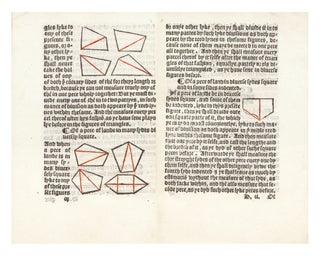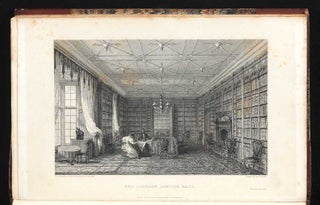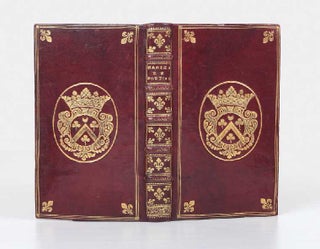Frank Hawley’s Set
Akino nanakusa ko [Thoughts about Seven Herbs in Autumn].
One full-page woodcut. .5, 29, .5; 15.5 folding leaves. Two vols. 8vo, orig. blue wrappers, orig. block-printed title labels on upper cover, later decorated wrappers, later stitching. From the colophon at end of Vol. II: Edo, Kyoto & Osaka: Hanabusaya Heikichi et al., 1812.
[with]:
—. Haru nanakusa ko [Thoughts about Seven Herbs in Spring]. Three full-page woodcuts & nine smaller woodcuts in the text. .5, 36 folding leaves. 8vo, orig. blue wrappers as above, later decorated wrappers, later stitching. From the colophon: Edo: Yamashiroya Sahei, 1814.
First editions, a rare complete set, of these two works, which are concerned with two important seasonal celebrations. The first of the year is the Festival of Seven Herbs in Spring (Nanakusa no sekku), a traditional Japanese ritual of eating seven-herb rice porridge on the 7th of January; its consumption would bring longevity and health and ward off evil. The tradition derives from ancient China. The seven herbs are seri (Japanese parsley), nazuna (shepherd’s purse), gogyo (cudweed), hakobera (chickweed), tahirako (nipplewort), suzuna (turnip), and suzushiro (daikon radish).
The other is the Festival of Seven Autumn Herbs (Akino nanakusa), less well known then the spring celebration. These herbs are hagi (bush clover), obana/susuki (Japanese pampas grass), kuzu (kudzu), nadeshiko (Japanese dianthus), ominaeshi (Patrinia scabiosifolia), fujibakama (Eupatorium fortunei), and kikyo (balloon flower). While many of them have medicinal qualities, for this festival they are not for eating but for viewing and admiring.
Kikuu Kitano (1762-1831), a native of Sendai, came to Edo in the 1780s and opened an antiques gallery that enjoyed great success. In 1804, he purchased a large piece of land in the Mukojima section of Edo, where he established a botanic garden, today known as the Mukojima Hyakkaen Garden. It is Tokyo’s only surviving garden from the Edo period. There he planted a landscaped orchard of 360 plum trees and other plants (including the seven herbs of both spring and autumn), selected by Kitano and his literati friends, both poets and painters.
These works are very beautifully printed, using a wide variety of character styles to express meanings and authorship. The first two volumes to be published — on the autumn festival — contain a fine full-page woodcut designed by the author, showing all seven herbs. The text contains references to each herb in waka and kanshi (Chinese poetry written by Japanese), a guide to understanding the nuances of the poetry, and the botanical literature.
The spring festival volume, published two years later, describes each of the seven spring herbs and their uses in medicine and gastronomy, with many references to the Japanese botanical literature. There is a long passage on how to prepare the springtime porridge. The woodcuts, depicting each of the seven herbs, are by prominent artists including Kita Busei (1776-1856) and an unidentified woman artist.
PROVENANCE: With the seals of Mayori (1829-1906) and Mamichi (1866-1925) Kurokawa, prominent father and son book collectors. Their collection was largely concerned with botanical and herbal books; most of the collection was destroyed in the great Kanto earthquake. Our set later entered the collection of Frank Hawley, scholar and one of the most discerning collectors of Japanese books and manuscripts. His stamp appears on the first page of text. See R.H. van Gulik’s “In Memoriam. Frank Hawley (1906-1961)” in Monumenta Nipponica, Vol. 16, No. 3/4 (Oct. 1960-Jan. 1961), pp. 434-47.
Fine set, preserved in a fine chitsu. With some mostly marginal worming, much of which has been carefully repaired.
Price: $7,500.00
Item ID: 8333

![Item ID: 8333 Akino nanakusa ko [Thoughts about Seven Herbs in Autumn]. KITANO, Kikuu, or Shuho.](https://jonathanahill.cdn.bibliopolis.com/pictures/8333.jpg?width=768&height=1000&fit=bounds&auto=webp&v=1659038733)
![Akino nanakusa ko [Thoughts about Seven Herbs in Autumn].](https://jonathanahill.cdn.bibliopolis.com/pictures/8333_2.jpg?width=320&height=427&fit=bounds&auto=webp&v=1659038733)
![Akino nanakusa ko [Thoughts about Seven Herbs in Autumn].](https://jonathanahill.cdn.bibliopolis.com/pictures/8333_3.jpg?width=320&height=427&fit=bounds&auto=webp&v=1659038733)
![Akino nanakusa ko [Thoughts about Seven Herbs in Autumn].](https://jonathanahill.cdn.bibliopolis.com/pictures/8333_4.jpg?width=320&height=427&fit=bounds&auto=webp&v=1659038733)
![Akino nanakusa ko [Thoughts about Seven Herbs in Autumn].](https://jonathanahill.cdn.bibliopolis.com/pictures/8333_5.jpg?width=320&height=427&fit=bounds&auto=webp&v=1659038733)
![Akino nanakusa ko [Thoughts about Seven Herbs in Autumn].](https://jonathanahill.cdn.bibliopolis.com/pictures/8333_6.jpg?width=320&height=427&fit=bounds&auto=webp&v=1659038733)
![Akino nanakusa ko [Thoughts about Seven Herbs in Autumn].](https://jonathanahill.cdn.bibliopolis.com/pictures/8333_7.jpg?width=320&height=427&fit=bounds&auto=webp&v=1659038733)
![Akino nanakusa ko [Thoughts about Seven Herbs in Autumn].](https://jonathanahill.cdn.bibliopolis.com/pictures/8333_8.jpg?width=320&height=427&fit=bounds&auto=webp&v=1659038733)
![Akino nanakusa ko [Thoughts about Seven Herbs in Autumn].](https://jonathanahill.cdn.bibliopolis.com/pictures/8333_9.jpg?width=320&height=427&fit=bounds&auto=webp&v=1659038733)


![From the upper cover: Fried. Krupp Essen A[m]/R[hein]. Deutschland. Friedrich KRUPP, Cast Steel Works.](https://jonathanahill.cdn.bibliopolis.com/pictures/6928.jpg?width=320&height=427&fit=bounds&auto=webp&v=1582901239)
